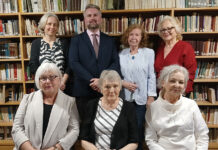
Recently the website bernardinai.lt published an article by Rev. Antanas Saulaitis, SJ, describing the closure of St. Joseph’s Church in Waterbury, Connecticut. Apparently, an unusual tradition back in the day was the collection of 25 cents per adult and 10 cents per child and homemaker for a seat in the pews. That was when wages were 50 cents an hour.
The history of this church is available in the Lithuanian Encyclopedia and in the three-volume work by Rev. Vincas Valkavičius (Wolkovich). The church was established by Lithuanian coalminers from Pennsylvania who came to Waterbury in the mid-19th century to work in copper, brass and watchmaking industries. Land was purchased and the parish was founded in 1894. In its heyday, from 1940 to 1960, the parish expanded to five or six thousand parishioners, or 2,000 families. Sadly, by 2023 their numbers fell to 80, with only 40 regularly attending Mass.
For a long time St. Joseph’s parish survived on the donations of its parishioners. It boasted a church, a rectory, a choir and even an orphanage that sheltered about 500 children over its 30 years of existence (after the post WWI influenza outbreak). It had a brass orchestra, bowling alley, primary school (Grades 1-8, with 800 pupils), an auditorium in the school, a French convent, a small printshop and newspaper, a bakery nearby that supplied dark rye bread (juoda duona). After WWII, about 500 Lithuanian refugees from Germany found shelter in this parish, where a multitude of Lithuanian organizations held their events, and where the Lithuanian Vyčiai organization is still active.
The founder of this and six other Lithuanian parishes in Connecticut was Rev. Juozas Žebrys. Later Rev. Juozapas Valantiejus served as pastor for 40 years. Folk artist Simas Augaitis arrived after the war and carved a Lithuanian cross which still welcomes visitors in front of the church.
Several factors sealed the fate of St. Joseph’s parish and church. In 1955 the Naugatuck River flooded during a hurricane, ruining a whole street of three-story houses owned by Lithuanians. The copper industry moved to the US South and later – abroad. Railroads were built right through areas populated and frequented by Lithuanians. Unfortunately, when a shortage of Lithuanian clergy began, the parish was assigned to a foreign priest who mismanaged and lost its 400,000 dollars in savings.
Many Lithuanian surnames survive in the Waterbury area, and there still a few associations functioning, as well as a Lithuanian cemetery. Once St. Joseph’s closes on September 24 after 130 years of service to the community, parishioners will join other local parishes.
– From bernardinai.lt



























